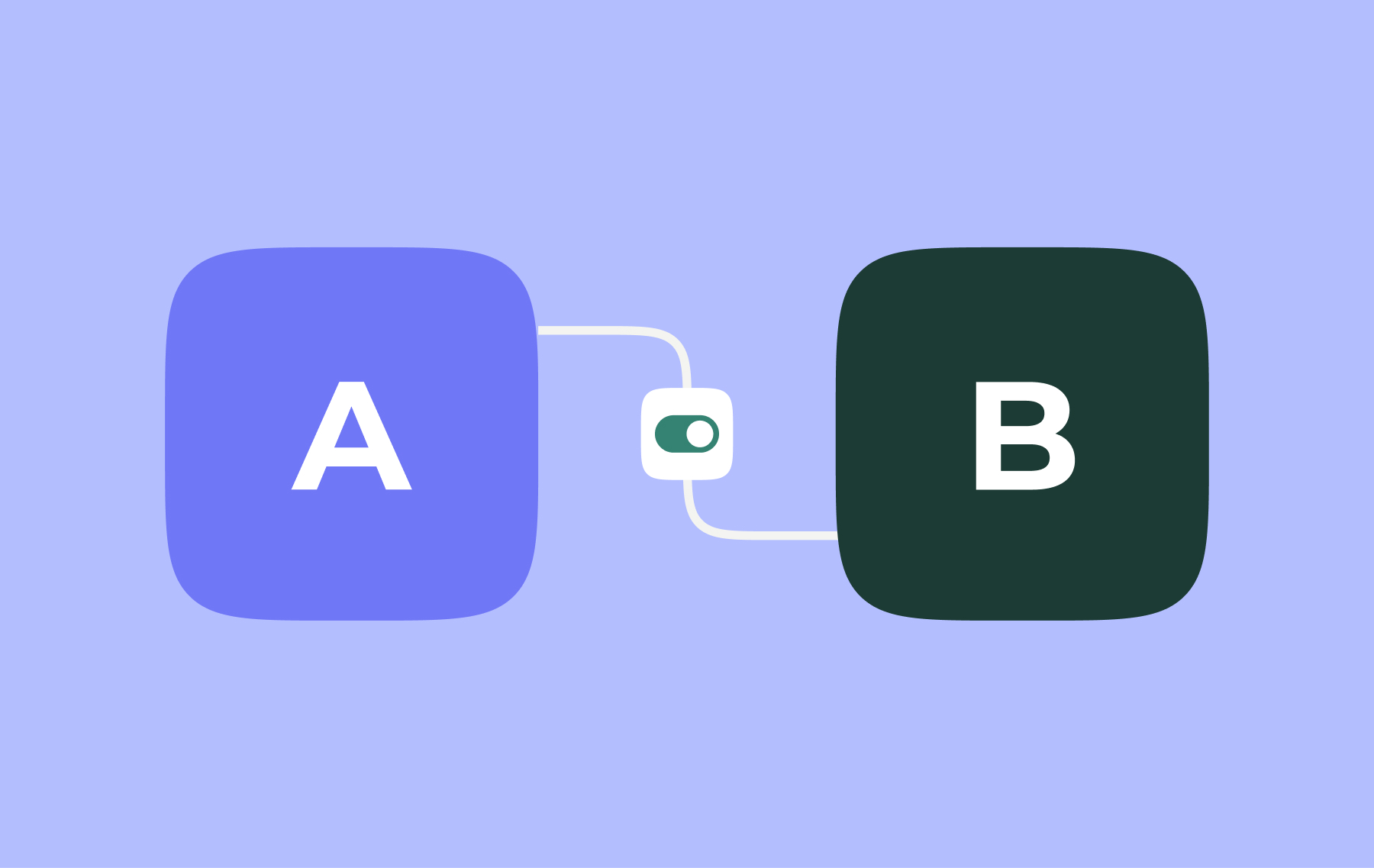What is blue-green deployment?

Both experimentation teams (including marketing and product) and engineering are often trying to move fast. Unfortunately, fast deployments aren't always possible, and a bad launch can easily kill an experiment before it can begin.
That's where blue-green deployment comes in.
Blue-green deployment is a software release approach that enables your organization to deploy software updates regularly while maintaining great user experience and minimal downtime. When used with a unified experimentation platform like Kameleoon, this continuous integration and delivery strategy uses two identical production environments to create a seamless transition process.
This model operates on a straightforward principle: you maintain two parallel production environments. The "blue" environment hosts your current live application that users actively access, while the "green" environment serves as the staging area for your upcoming release. This dual-environment approach provides both flexibility and security in your deployment process.
How blue-green deployment works
When preparing for a release, you typically use a template from a previous successful sprint to establish your green environment baseline. You then deploy your new code to this green environment, where you can conduct comprehensive testing and validation under actual production conditions. This approach allows you to identify and resolve potential issues before they impact your user base, ensuring that your updates meet quality standards.
The transition process involves redirecting user traffic from the blue environment to the green environment once you have verified that the new version performs as expected. The strength of the blue-green deployment model lies in maintaining both environments during the initial rollout period. You preserve the blue environment while monitoring the green environment's performance, which provides you with immediate rollback capabilities.
Should unforeseen issues arise with the new deployment, you can quickly redirect traffic back to the blue environment without service interruption. This failsafe mechanism ensures app continuity and protects user experience, even when encountering unexpected challenges that weren't detected during testing phases.
Kameleoon allows marketers, product teams, and developers to work together during blue-green deployments. For example, while engineering teams deploy new features behind a flag in the green environment, marketers can use Kameleoon to track engagement, conversions, and user behavior.
Blue-green deployments typically require input from engineering, but the relative safety of the practice makes it a good system for product and marketing teams to take advantage of should they want to explore feature experimentation as part of a broader experimentation-led growth strategy.
An example of blue-green deployment
Let’s say you have a running app that features monthly themes and challenges. Your current production environment displays a September theme with its associated running activities; this represents your blue environment. As October approaches, you need to implement a Halloween theme along with new monthly and weekly running challenges.
You begin by creating an identical production environment that mirrors your September theme setup. This becomes your green environment, where you'll develop the Halloween theme and its corresponding challenges. The development process involves deploying your code changes to this green environment and conducting thorough testing to ensure optimal performance.
Once you've validated that the Halloween theme functions correctly, you use a load balancer to redirect user traffic from the September environment to the Halloween environment. This transition occurs seamlessly from the user's perspective, maintaining service continuity throughout the process.
Following the traffic switch, you continuously monitor the Halloween theme's performance to identify any potential issues. Should problems arise, you can immediately redirect traffic back to the September environment, which remains available as your fallback option.
When the Halloween version demonstrates stable performance over time, it transitions into your new blue environment. The former blue environment containing the September theme can then be decommissioned from active production and repurposed as the template foundation for your next deployment sprint in November.
Advantages of blue-green deployment
Blue-green deployment model offers many benefits that make it a great software deployment strategy for your organization.
One of these is its minimal downtime during app updates. Since you are switching traffic between two fully operational production environments rather than taking your application offline for updates, the actual downtime experienced by users becomes negligible. This traffic redirection happens almost instantaneously, which means your users can continue using your application without experiencing the traditional service interruptions associated with regular software service updates.
Silver Ringvee, CTO at Speero, agrees:
My top 2 benefits of using blue-green deployment are zero downtime and quick rollback (if needed). I've seen this be a game changer in disaster recovery in the past.
—Silver Ringvee
Chief Technology Officer, Speero
The ability to execute immediate rollbacks to your blue environment provides a crucial safety mechanism when unexpected issues arise. This combination of minimal downtime and rapid recovery capabilities enhances your app reliability. When your users experience consistent and uninterrupted service, they develop greater confidence in your platform, which translates into improved user retention and engagement levels.
Blue-green deployment also delivers clear deployment history tracking, which proves invaluable in highly regulated industries. Financial services and healthcare organizations, for instance, operate under strict compliance requirements that demand comprehensive audit trails. When compliance teams need to review your deployment practices, having a well-documented history of each blue-green transition provides the transparency and accountability these sectors require. This detailed record-keeping helps your organization show its commitment to operational excellence during compliance audits and regulatory reviews.
Considerations for blue-green deployment
Despite its advantages, blue-green deployment presents certain challenges that you need to consider before implementing this strategy in your organization. Understanding these challenges can help you make an informed decision about whether this deployment method aligns with your organization’s operational requirements.
One important consideration is the resource-intensive nature of maintaining dual production environments. Blue-green deployment requires you to double your infrastructure investment, as you need sufficient resources to run two complete production systems simultaneously.
The financial implications can be substantial, especially if your organization has complex, resource-heavy applications or operating with a tight budget. These infrastructure costs extend beyond just server capacity to include storage, networking, monitoring tools, and ongoing maintenance expenses for both environments.
This cost structure may render blue-green deployment economically unfeasible, regardless of its technical benefits. In this case, you should consider other software deployment strategies like rolling deployments or canary releases which offer similar benefits.
In rolling deployments, you gradually update changes within a single environment. While canary testing allows you to validate changes with a small subset of users before full rollout. Both strategies offer improved deployment safety without the full infrastructure duplication that blue-green requires.
Beyond cost considerations, blue-green deployment may be impractical for your organization to run in some cases. If your organization has extensive microservice architectures, for instance, you may find it difficult coordinating deployments across multiple interconnected services in two dual environments. This complexity increases when you consider service dependencies, version compatibility, and the intricate orchestration required to ensure all components work in tandem across both environments.
Another instance involves database management. When your app relies on stateful data stores, you face the task of maintaining data consistency between environments. Or implementing sophisticated database migration strategies. While it's possible to handle database transitions within a blue-green model, the additional overhead often outweighs the benefits. You might need to implement database replication, manage schema migrations carefully, or develop complex data synchronization mechanisms. All of these introduce potential failure points and operational complexity that simpler deployment models avoid entirely.
Ringvee offers some advice:
Since blue-green deployment can be difficult to manage, requires more resources and isn't ideal for all use cases, I would recommend that engineers consider alternatives first. If it's agreed that blue-green deployment is the best way to go, then it requires some close coordination with all stakeholders to make sure it goes smoothly.
—Silver Ringvee
Chief Technology Officer, Speero
The operational complexity of blue-green deployment extends to team management and workflow coordination as well. Managing dual production environments introduces numerous moving parts that can overwhelm your organization if you lack robust DevOps practices. The coordination required between infrastructure management, monitoring systems, load balancer configurations, and environment synchronization demands a level of operational maturity that not every company has.
Blue-green deployment requires a fundamental shift in development practices that some teams may struggle to adopt. The model works optimally when you maintain continuous deployment habits, regularly pushing small, incremental changes to your green environment rather than accumulating large batches of updates.
If your team is used to traditional development cycles, you may fall into the trap of building substantial change backlogs in their development environments before attempting deployment. When these accumulated changes finally reach the green environment, the sheer volume and complexity can create integration challenges, debugging difficulties, and increased risk of deployment failures, essentially undermining the benefits of blue-green deployment you wanted in the first place.
How to implement blue-green deployment
Implementing blue-green deployment successfully requires extensive planning and execution. Let’s use the running app example where you transition from September to a Halloween-themed October update.
Infrastructure setup
You start by establishing two identical production environments. Your current September environment serves as the blue environment, while you provision a green environment with matching server specifications, database configurations, and monitoring capabilities. Include load balancers for traffic switching and comprehensive monitoring systems across both environments.
Development and deployment
Start by creating a snapshot of your blue environment as the baseline for green. Deploy the Halloween theme updates to the green environment, including visual design changes (your halloween theme), the monthly running challenge, and four weekly challenges. Implement comprehensive testing protocols that validate challenge functionality, user interface rendering, integration with user profiles, and system performance under load.
Testing and validation
Simulate real-world conditions in your green environment by importing user data, running synthetic user interactions, and validating external service integrations. Specifically, test that users can register for the Halloween challenge, access weekly challenges, view progress in the new interface, and maintain historical running data. If database schema changes are required, thoroughly test migration scripts and rollback procedures.
Traffic switching and monitoring
Use your load balancer to redirect traffic from blue to green, either instantly or gradually. Monitor key metrics including response times, error rates, user engagement, and challenge completion rates. Track Halloween challenge registration, weekly challenge completion, and user interface interactions. Maintain intensive monitoring for several days while keeping the blue environment ready for immediate traffic resumption.
Rollback and stabilization
Establish clear rollback criteria including error rate thresholds and performance benchmarks that trigger immediate traffic redirection to blue. Once the Halloween theme demonstrates stable performance, it becomes your new blue environment, and the former blue environment can serve as the template for the next deployment cycle.
This cyclical process maintains continuous deployment capability while preserving the safety net essential for user-critical applications.
Blue-green deployment and A/B testing
Blue-green deployment provides an excellent foundation for conducting A/B testing at scale. The process leverages your existing dual-environment setup, where you deploy your experimental changes to the green environment while maintaining your current version as the control in the blue environment.
Using load balancer configuration, you split incoming traffic between both environments and measure performance against key metrics such as conversion rates, user engagement, or feature adoption rates. This approach allows you to gather statistically significant data while maintaining the ability to quickly redirect all traffic to the better-performing version based on your test results.
Ringvee also points out another use case for blue-green deployment in A/B testing:
The only other use case in experimentation that I would point out is when in-house engineers are implementing winning variants from A/B testing to make sure the deployment of those changes is handled safely, and the process of rollback would be fast if needed.
—Silver Ringvee
Chief Technology Officer, Speero
Alternatively, you can implement progressive delivery by gradually increasing the green environment's traffic allocation in small increments until your traffic is fully transferred. This flexibility allows you to balance risk management with performance optimization based on your organization's specific requirements and risk tolerance.
Other use cases for blue-green deployment
Beyond A/B testing, you can use blue-green deployment for other purposes like:
Quick deployment cycles
Blue-green deployment enables your team to release updates without waiting for low-traffic periods or scheduling maintenance windows. The instant traffic redirection capability eliminates traditional deployment downtime, allowing you to push updates during peak usage hours without service interruption. This flexibility significantly improves your release velocity and responsiveness to user and market demands.
Production environment testing
With blue-green deployment, you can authentically validate code behavior under real-world conditions. Since both environments maintain identical configurations, you can observe how new features perform with actual production workloads, data volumes, and user interaction patterns. This approach reveals issues that staging environments might miss, improving overall system reliability and reducing post-deployment surprises.
Controlled feature rollouts
Blue-green deployment becomes particularly powerful when combined with feature flag management. Let’s say you wanted to add a charity fundraising challenge in your running app’s Halloween release. By placing this fundraiser behind a feature flag in the green environment, you can enable registration for a small user segment initially, perhaps 10% of your user base.
Monitor engagement metrics and system performance while gradually expanding access to additional user groups. This approach allows you to validate feature stability and user adoption patterns before full deployment. Should issues arise with the fundraising challenge, you can disable the feature flag without affecting the broader October release, maintaining system stability while preserving your deployment timeline.
How will you use blue-green deployment?
Blue-green deployment is a powerful strategy that blends innovation with reliability. While it demands solid infrastructure and operational maturity, the payoff is faster, safer releases and better risk control. Its dual-environment setup not only minimizes downtime but also supports techniques like A/B testing and gradual rollouts; key for high-stakes, user-facing systems.
That said, it’s not a one-size-fits-all solution. Complex microservices, heavy database changes, or tight infrastructure budgets might make other strategies more practical. The real trick is knowing your team’s capabilities and matching them to the right deployment model.
With thoughtful implementation, blue-green deployment can turn releases from risky events into smooth, repeatable operations, helping your team move faster, deliver confidently, and keep services reliably online.
Whether you’re deploying features behind flags or gradually rolling out changes with progressive delivery, Kameleoon helps your team collaborate without compromise. Click below to learn more!





